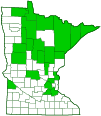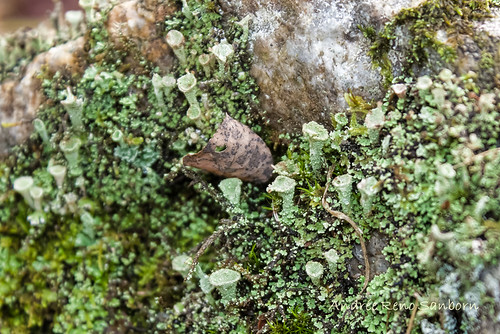Trumpet Lichen
(Cladonia fimbriata)
Conservation • Description • Ecology • Distribution • Taxonomy
|
|
||||||||||||||
Description |
Trumpet Lichen is a common, cosmopolitan, pixie cup lichen. It occurs worldwide on every continent including Antarctica. In the United States it is common in the east and in the west, but it is mostly absent from the deep south, the desert southwest, the Great Plains, and the Great Basin. It grows under full sun or partial shade, on humus-rich soil, on rotting logs and stumps, and on tree bases. Trumpet Lichen produces two types of vegetative growth (thallus). The primary thallus is a leaf-like scale (squamule) that lies on the soil. The squamules are up to ¼″ (6 mm) long and ⅛″ (4 mm) wide. They are numerous but often small and inconspicuous. The margins may be toothed, lobed, or simply wavy. The surface is green to grayish-green or whitish-gray and is coarsely covered with granules (soredia), especially under the margins. The squamules are persistent, remaining as the secondary thallus matures, but they sometimes break up into clumps of soredia. The secondary thallus is a vertical, unbranched, ¼″ to 13⁄16″ (6 to 30 mm) tall, 1 ⁄32″ to 1 ⁄16″ (1 to 2 mm) thick stalk (podetium) that rises from the center of a squamule. It is green when growing in the shade, grayish-green to whitish-gray when exposed to the sun. It is covered by a thick, persistent layer of very fine soredia. The layer of protective tissue (cortex) may be complete up to the cup, just at the base, or entirely missing. The stalks broaden gradually at the tip into a 1 ⁄32″ to ⅛″ (2 to 6 mm) wide, symmetrical, strongly convex, trumpet-shaped cup. This is the feature that gives the lichen its common name. The margins are unlobed and untoothed, or minutely toothed. Reproductive structures (apothecia) on the margins of the cup are uncommon. When present, they are brown and up to 1⁄16″ (1.5 mm) in diameter. |
Similar Species |
Felt Horn Lichen (Cladonia phyllophora) is larger. The squamules are up to ⅝″ (15 mm) long, and they often disappear as the secondary thallus matures. The podetia are up to 3⅛″ (80 mm) tall. Apothecia are abundant. |
Ecology |
Substrate |
Ground |
Growth Form |
Fruticose |
Habitat |
|
Hosts |
|
Distribution |
||
|
Sources |
|
| 1/9/2025 | ||
Occurrence |
||
Common |
||
Taxonomy |
|
Kingdom |
Fungi (fungi including lichens) |
Subkingdom |
Dikarya |
Phylum |
Ascomycota (Sac Fungi) |
Subphylum |
Pezizomycotina (Sac Fungi and Lichens) |
Class |
Lecanoromycetes (Common Lichens) |
Subclass |
Lecanoromycetidae (Shield Lichens, Sunburst Lichens, Rosette Lichens, and Allies) |
Order |
Lecanorales (Shield Lichens, Rim Lichens, and Allies) |
Family |
Cladoniaceae (Spindles and Structured Lichens) |
Genus |
Cladonia (Pixie Cup and Reindeer Lichens) |
Mycobiont |
Cladonia fimbriata |
Photobiont |
|
Subordinate Taxa |
|
|
|
Synonyms |
|
Cenomyce pyxidata var. fimbriata Cladonia major Lichen fimbriatus Lichen major Lichen simplex |
|
Common Names |
|
Cup Lichen Powdered Trumpet Lichen Trumpet Cup Lichen Trumpet Lichen |
|
Glossary
Apothecium
An open, disk-shaped or cup-shaped, reproductive structure, with spore sacs on the upper surface, that produces spores for the fungal partner of a lichen. Plural: apothecia.
Fruticose
Shrubby: referring to the growh form of lichens that may be tufted, draped, or stalked.
Podetium
The hollow stalk of the fruiting body of lichens in the genus Cladonia. Plural: podetia.
Soredium
An asexual reproductive structure of a lichen in the form of a tiny dull granule on the thallus surface that can be easily brushed off. It consists of a cluster of algal cells (the photobiont) wrapped in fungal filaments (the mycobiont), but without an outer layer of protective tissue (cortex). Plural: soredia.
Squamules
On lichens: small, flat, often overlapping, leaf-like scales without a lower cortex. Adjective: squamulose
Thallus
The vegetative body of a lichen composed of both the alga and the fungus.
Visitor Photos |
||
Share your photo of this lichen. |
||
This button not working for you? |
||
Luciearl |
||
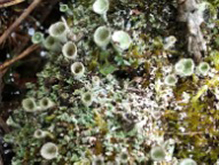 |
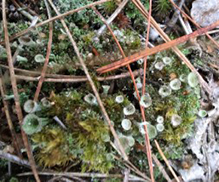 |
|
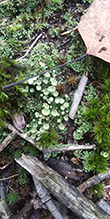 |
||
MinnesotaSeasons.com Photos |
||
|
||
|

Visitor Videos |
||
Share your video of this lichen. |
||
This button not working for you? |
||
|
Other Videos |
||
CLADONIA FIMBRIATA- |
About
Nov 28, 2020+ Although the phylogeny of the genus Cladonia is still under investigation, two main morphological groups are mainly differentiated by taxonomists: Cladonia morphotype and Cladina morphotype. The Cladonia morphotype has many more species, and is generally described as a group of scaly (grow from scales). Those of the Cladina morphotype are often referred to as forage lichens, mat-forming lichens, or reindeer lichens (due to their importance as winter forage for caribou). |

Created: 10/18/2023 Last Updated: © MinnesotaSeasons.com. All rights reserved. |
